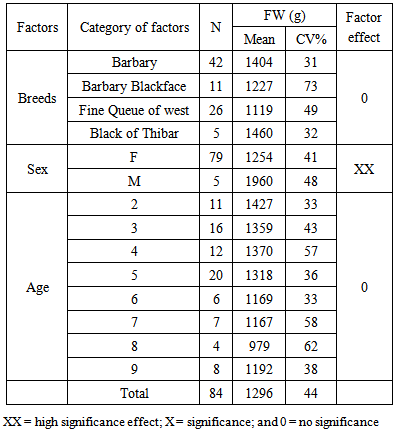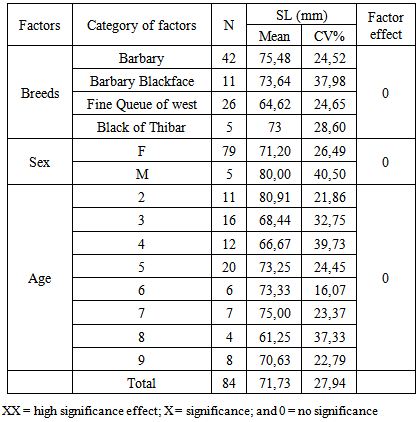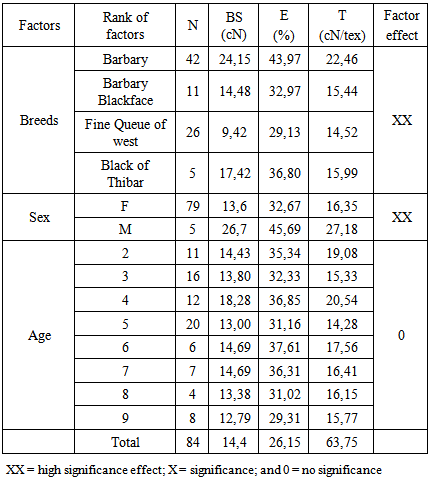-
Paper Information
- Next Paper
- Paper Submission
-
Journal Information
- About This Journal
- Editorial Board
- Current Issue
- Archive
- Author Guidelines
- Contact Us
International Journal of Textile Science
p-ISSN: 2325-0119 e-ISSN: 2325-0100
2015; 4(5): 97-101
doi:10.5923/j.textile.20150405.01

Variation in Fleece Characteristics of Tunisian Sheep
T. Harizi1, F. Abidi1, R. Hamdaoui2, Y. Ben Ameur2
1Textile Engineering Laboratory, University of Monastir, Monastir, Tunisia
2Technical Center of Creation, Innovation, and Supervision in Carpet and Weaving, Tunis, Tunisia
Correspondence to: T. Harizi, Textile Engineering Laboratory, University of Monastir, Monastir, Tunisia.
| Email: |  |
Copyright © 2015 Scientific & Academic Publishing. All Rights Reserved.
This work is licensed under the Creative Commons Attribution International License (CC BY).
http://creativecommons.org/licenses/by/4.0/

This experiment was aimed to identify wool quality of Tunisian sheep breeds. Fiber characteristics of different ages and various sheep breeds were studied. A total of 84 sheep were used in this study. Results show that the factor 'breed' had a highly significant effect on all controlled parameters accept scoured yield and fibre length. Breed was the most important factor. By conducting well-planned sorting, “Fine Queue of west” sheep breed can supply the wool needed for textile industries. The wool of other sheep breeds can be used in handmade carpets.
Keywords: Sheep, Fleece, Wool, Staple length, Fiber diameter
Cite this paper: T. Harizi, F. Abidi, R. Hamdaoui, Y. Ben Ameur, Variation in Fleece Characteristics of Tunisian Sheep, International Journal of Textile Science, Vol. 4 No. 5, 2015, pp. 97-101. doi: 10.5923/j.textile.20150405.01.
Article Outline
1. Introduction
- Sheep farming in Tunisia occupies an important place in the economic and social level, on the one hand, it can cover 41% of the consumption of red meats [1] and secondly, it contributes at 35-40% of agricultural GDP and 4 to 5% of global GDP [2].Meat production is the first priority of sheep breeding in Tunisia and wool production is second or third purpose. The sheep population in Tunisia was 7.234 million heads in 2010 [3]. It is mainly constituted by five different breeds; Barbary, fine Queue Western, Black of Thibar, Sicilo-Sarde and other breeds or populations representing respectively 60.3; 34.6; 2.1; 0.7 and 2.3% of the total national sheep population [4].All Tunisian sheep breeds are coated annually. The fleece of sheep grows from specialized follicles in the skin. While primary follicles bear medullated outer coat coarse fiber (hair) and provide mechanical protection, secondary follicles produce non-medullated inner coat fine fiber or true-wool which provides thermal protection. Habitually, Tunisian wool produced by sheep breeds plays an important role both as an important source of income to farmers and as a supply of raw material for hand-woven carpet. In recent years, an important quantity of produced wool is discarded or burned because the price paid for the fleeces is very low. Logically, the price paid for the fleeces is based on fleece characteristics. However, until now, no technical data is available on Tunisian sheep fiber characteristics.Generally, wool and other animal fibres are traded and priced on the international market according to a number of special criteria. These include fibre diameter, fibre length, luster (’shinyness’), crimp (’wavyness’) and percentage yield of clean fibre from raw fibre, following scouring (washing) to remove vegetable and mineral contaminants and wool grease. In the literature, several researches report the effect of age, breed, sex… on fleece characteristics. In order to optimum use of Tunisian sheep wool, it is necessary to investigate the wool characteristics of the different Tunisian sheep breeds. Many factors determine the quality (and value) of wool. These include fiber diameter, crimp, yield, color, purity, and staple length and strength.Accordingly this paper studies wool quality and its variation of different sheep breeds in different regions of Tunisia in order to determine the scope for improvement and future utility.
2. Materials and Methods
- Analyzed samples are taken from sheep located in the governorates of Zaghouan, Beja and Kef. Selected sheep are of different ages and various breeds (Barbary, fine Queue of West and Black of Thibar). A total of 84 sheep (5 males and 79 females) were used in this study.Greasy fleece weights were determined by digital balance at shearing in April. Approximately 100 gram wool samples were taken from the mid-side of each animal and were put in plastic sample bags. Wool samples were sent for analyzes to an Australian Laboratory "Southern Tablelands Fibre Testing" where staple length (SL), mean fiber diameter (MFD), coefficient of variation of fiber diameter (FDCV) and fine fiber contain (FC) were measured using OFDA 2000. The mechanical properties of simple fibres were controlled by using a Shirley dynamometer with constant gradient rate of 20 mm/min and 25-mm test length in accordance with the standard NF G 07 002.To determine the percentage of clean wool weight, net bags containing samples were weighed immediately, immersed in three scouring bowls solution containing 0.3% of Na2CO3 and 0.1% of soap and water and stirred for 15 minutes at a temperature of 52±3°C. This procedure was repeated once more but only with warm water. Washed samples were oven-dried and weighed and the percentage of clean wool weight was calculated.SY=100*(raw wool weight – scoured wool weight)/raw wool weightData were analyzed using Minitab in a one-way ANOVA design with breed, sex and age as main effects. Tukey’s test was used to separate differences in the means.
3. Results and Discussion
3.1. Fleece Weight
- The raw fleece weight is a good indicator of total output as it gathers the combined effect of the fineness, length and density. Table 1 presents the results of Tunisian wool fleece weight. The average weight of the raw fleece is 1.296 kg, which is lower than the world average fleece (2.4 kg / sheep). This is a lightweight fleece but is still higher than some sheep breeds such as in Iran where the average fleece weight does not exceed 0.7 kg [5-7] and less than the others [8, 9]. Also, the important value of CV% (44%) shows a high variability of the fleece weight which seems logical since as the samples are taken from sheep of different breeds, regions and ages.
|
3.2. Scoured Yield
- Washing wool removes grease, fat and mineral impurities earth and sand. Yield expressed as a percentage of the amount remaining after washing wool, compared to the amount of raw wool (greasy).
|
3.3. Wool Diameter
- The fineness is the most important characteristic of wool, since largely determines its commercial value. The wool fineness is, generally, expressed in terms of average fibre diameter and the unit of measurement is the micrometer (µm). Table 3 presents the results of wool diameter measurements of different sheep breeds. The average Tunisian wool diameter is 28.99µm with a FDCV% of 26.15%. The mean FD of Tunisian breeds was 30.1, 32.3, 24.9 and 32.5% for Barbary, Barbary black face, fine Queue of West and Black of Thibar respectively. Overall fiber diameter of wool in this study is lower than Middle Eastern carpet wool sheep breeds, 36.0 μm for Awassi [13], 35.4 μm for Ossimi [17], 38.4 μm for Barbary [18] and 39.1-40.2 μm for Karakaya [19]. The average percentage of fine fibers (diameter less than 30 µm) in the end product (FC) is 63.75%. This probably explains the increase in the average fineness of the Tunisian wool. According to the systems of wool grading [20], the Tunisian wool is considered as medium wool. In this grading wool there are four grades; Fine (diameter lower than 22 µm), Medium (diameter ranged from 22 to 31 µm), Coarser (diameter ranged from 31 to 36 µm) and very coarser (diameter more than 36 µm).The average wool diameters of sheep breed "Fine Queue of West" that is 24.96 µm, is lowest when compared to the mean wool diameters from other breeds, the difference between means was highly significant (p <0.01). Also, the data analysis (one-way ANOVA) shows a highly significant effect of the factor 'breed'. Even though not significant, males had slightly lower fiber diameter than females. Two years old sheep had lower fiber diameter than older sheep. Factors 'age' and 'sex' contribute to the variation in the average wool diameters without they have a significant effect. Karakus et al. [10] and Civi [21] had not observed a difference between Karakas and Norduz lamb for wool diameter. Effect of sex is not important on wool diameter of Akkaraman sheep [22]. Furthermore, Tabbaa et al. [13] noted that wool diameter have not importance differences among Awassi sheep at different sex and ages.The wool samples have an average diameter ranging from 21.1 µm to 39.3 µm and the FDCV ranges from 24.05% to 28.33%. This shows a large dispersion of the wool diameter which confirming that the standard uniformity [20] of the Tunisian wool goes from average to poor. Also, we noted that the percentage of fine fibers (FC) has a highly significant effect (p <0.001) on the average diameter and FDCV%. Therefore, a decrease in the percentage of coarse fibers (> 30 µm) causes a decrease in the average wool diameter and FDCV%. This shows the importance of selection against coarse fibres.
3.4. Wool Length
- The fiber length affects how wool can be used. Very short fibers are used in felting process. In spinning, depending on fiber length, there are three processes: worsted, semi-worsted and carded. The length of the wool fiber has a direct influence on the spinning speed, the yarn title and the yarn quality. Table 4 presents the results of wool length measurements of different sheep breeds.Average wool staple length was 71.7 mm (Table 4) with an individual sheep range of 64.6-81 mm. Males had longer staple length than females and two years old sheep had longer length than older sheep. There was no significant (p value < 0.2) difference in the staple length of different breeds. The breed of fine Queue of West, with an average of 64,6 mm, had the shortest staple length. The staple length of Tunisian sheep breeds of the present study is lower than that of Afshari, Zandi, Mehrabani, Lori, and Baluchi sheep in Iran [16], Awassi sheep in Jordan 140.0 mm [13] and Barbary sheep in Libya 120.2 mm [18].According to the Canadian Sheep Federation [23], for wool fineness of 26µm to 30.1 µm the suggested length is between 75 and 90 mm. So the Tunisian wool has an average length relatively lower promoted value.
|
3.5. Wool Mechanical Proprieties
- Fibre strength is very important in the spinning step, because in this procedure wool fibres should be combed and spun to produce yarn. Thus, fibres should have enough strength to withstand against various mechanical and physical tensions. Staple strength is second in importance to diameter in determining the price of greasy wool in Australia [24-26].In the present study, the mean of fiber tenacity and breaking strength were evaluated to 16,2 cN/tex and 14,4 cN respectively (table 5) which are very higher than the required thresholds of the spinning process. In the textile industry, wool fibres should have at least 6 cN/tex of tenacity to withstand against physical and mechanical tensions and breaking [27]. So, it be concluded that Tunisian wool fibres have a desirable tenacity and breaking strength for using in textile industry. Also, Tunisian wool have better tenacity than of same Iranian and Turkish wool, which had a tenacity estimated to 12,2 cN/tex [30] and 9,5 cN/tex [10] respectively. But, t is lower than the average staple strength of Australian wool which is around 35 cN/tex [25] and that of New Zealand wool which is 41 cN/tex [29].The mean of elongation of Tunisian wool was estimated to 36,5% (table 5) which is very higher than of same Iranian and Turkish wool, which had a tenacity estimated to 29% [28] and 27,2% [10] respectively. Because the desirable elongation at break for wool fibres is between 40-50% [27], it seems that wool fibres of Tunisian sheep breeds (except the "Barbary" breed) have an adequate but not desirable grade in this mechanical point of view. The Barbary breed has an average of fiber tenacity, breaking strength and elongation equal to 22,5 cN/tex, 24 cN and 44% respectively (table 5). This indicates good mechanical proprieties like that found for Australian merino wool [25]. The results of the analyses of variances for mechanicals proprieties of Tunisian wool are presented in table 5. The factors “breed” and “sex” had a very significant effect on breaking strength and elongation parameters (p<0,01). Nevertheless, “Age” factor was not significant on the cited parameters (p>0,05).
|
5. Conclusions
- This research described the results of experiment for improving the wool production and quality involving of Tunisian sheep. Improving wool quality helps sheepmen earn more income and facilitates the development of textile industry. There are differences between Tunisian sheep breeds in the way the fibers they produce. The factors age, sex and breed have greater or lesser effects on controlled parameters (fiber diameter, staple length, breaking strength, elongation, fleece weight and the scoured yield). Nevertheless, breed is the most important factor. In fact, the breed ‘Fine Queue of west’ has ability to produce finer fibres with more uniformity. So, it can supply the wool needed for textile industries. The wool of other sheep breeds can be used in handmade carpets.
References
| [1] | OEP, 2011; Office d’Elevage et de Pâturage en Tunisie. |
| [2] | GIVLAIT, 2008 http://www.givlait.com.tn/index.php?option=com_content&view=article&id=38&Itemid=45. |
| [3] | INS, 2011; Rapport de l’Institut National de Statistique en Tunisie. |
| [4] | Rouissi, H., N. Ben Souissi, S. Dridi, K. Chaieb, S. Tlili and J. Ridene, (2001): Performances Zootechniques de la race ovine Sicilo-Sarde en Tunisie. Options méditerranéennes, serie A, 46: 231-236. |
| [5] | Taherpour N. and Farhad Mirzaei (2012): Wool characteristics of crossbred Baghdadi wild ram and Iran native sheep. Agricultural Sciences 3 (2012) 184-186. |
| [6] | Demiruren, A.S., Beheshti, R.D., Salimi, H., Saleh, B.A. and Djaffari, A. (1971) A comparison of the reproductive and productive capacities of sheep Kallekui, Kizil and Baluochi breeds in Iran. Technical report, No. 1, Animal Husbandry Research Institute. |
| [7] | Makarechian, M., Farid, A. and Safidbakht, N. (1977) Wool production in some fat tailed Iranian sheep breeds. 1—Some quantities characteristics of Karakul, Mehraban, Naeini, Ghezel and Bakhtiari breeds. Iran Journal Agricultural Research, 5, 15. |
| [8] | Salehi, M. and Taherpour, N. (1992) Evaluation on wool characteristics of Iranian sheep breeds 2—Sangsari sheep breed. Animal Science Research Institute, Final report, Ministry of Agriculture, Iran. |
| [9] | Sohraby, S. (1937) Les races de moutons et laine de I’Iran. Thèse présentée à la Faculté des sciences de l’Université de Paris pour obtenir le titre de docteur de l’Université. |
| [10] | Kadir Karakus, Selcuk Seckin Tuncer and Serhat Arslan. Comparison of the Fleece Characteristics of Karakas and Norduz Sheep (Local Ewes in Turkey). Journal of Animal and Veterinary Advances Year: 2005 | Volume: 4 | Issue: 6 | Page No.: 563-565. |
| [11] | Sidwell, G.M. and Miller, L.R. Production in some pure breeds of sheep. J. Anim. Sci. 1971; 32: 1099–1102. |
| [12] | Al-Azzawi, W. A. (1977). A comparative study of fleece characteristics in Iraq sheep. MSc Thesis, Faculty of Agriculture, University of Cairo. Egypt. |
| [13] | Tabbaa, M. J., W. A. Al-Azzawi, & D. Campbell. 2001. Variation in fleece characteristics of Awassi sheep at different ages. Small Ruminant Research. 41: 95-100. http://dx.doi.org/10.1016/S0921-4488(01)00203-6. |
| [14] | Wuliji, T., Dodds, K.G., Andrews, R.N. and Turner, P.R. (2011) Selection response to fleece weight, wool characteristics, and heritability estimated in yearling Romney sheep. Livestock Science, 135, 2631. doi:10.1016/j.livsci.2010.06.003. |
| [15] | SID. (1988): Sheep Production Handbook, Third Edition,. Sheep industry program, Inc., Denver, CO. |
| [16] | Ansari-Renani, H. R. (2012). Fiber Quality of Iranian Carpet-Wool Sheep Breeds. Media Peternakan-Journal of Animal Science and Technology. Vol 35, No 3 (2012), pp. 179-184. |
| [17] | Maria, I. F. M., G. M. Gebriel, & I. Abou-Fandoud. 1992. Relationships between blood groups and some wool characteristics in Egyption coarse-wool fat-tail sheep. Anim. Prod. 55: 123-127.http://dx.doi.org/10.1017/S000335610003734X. |
| [18] | Akraim, F., I. S. Milad, A. A. A. Abdulkarim, & M. Ganem. 2008. Wool characteristics of Libyan sheep in north-eastern Libya. I. Fiber diameter and staple length. Livestock Research for Rural Development. 20 (8). |
| [19] | Cimen, M. 2006. The effect of birth type and sex of lambs on fiber diameter. Res. J. Agric. Biol. Sci. 2: 509-511. |
| [20] | Rodney Kott, 1993. I-1 (Wool Production and Marketing) http://msuextension.org/publications/AgandNaturalResources/MT198380AG.pdf. |
| [21] | Civi A., 1999. Fleece weights and characteristics in Karakas and Norduz lamb. Phd. Dissertation, YYU, Graduate Enst., Van, Turkey, pp: 269. |
| [22] | Çorekci, S.G. and Evrum, M., 2000. Comparative studies on the production performances of Chios and Imroz breeds kept under semi-intensive conditions II. Milk production, fleece yields and characteristics, Turkish Journal of Veterinary and Animal Science, 24, 545–552. |
| [23] | Canadian Sheep Federation (1986). Wool Production in Canada.https://www.google.tn/. |
| [24] | Anonymous, Staple measurements, AWTA Ltd. Newsletter, Victoria, Australia, October 2007. |
| [25] | Rogan, I.M. Wool Technol. Sheep Breed. 43(4) (1995) pp. 295–306. |
| [26] | Bow, M.R. Staple length, in Proceedings of the seminar ‘Staple Length and Staple Strength of Greasy Wool: Measurement and Effects on Worsted Processing’, CSIRO Division of Textile Physics, Ryde, New South Wales, December 1979. |
| [27] | Klein, W. 1986. The technology of short-staple spinning, the textile institute, Academic Press. New York, pp 180-240. |
| [28] | Edriss MA, Dashab G, Ghareh Aghaji AA, Nilforooshan MA, Movassagh H. A study on some physical attributes of Naeini sheep wool for textile industry. Pak J Biol Sci. 2007 Feb 1;10(3):415-20. |
| [29] | Knowles, D.G. The relationship between New Zealand merino fleece measurement produced at NZPAC Ltd. and their corresponding core test results, IWTO Report No. RWG 03, Christchurch, New Zealand, April 2000. |
 Abstract
Abstract Reference
Reference Full-Text PDF
Full-Text PDF Full-text HTML
Full-text HTML



